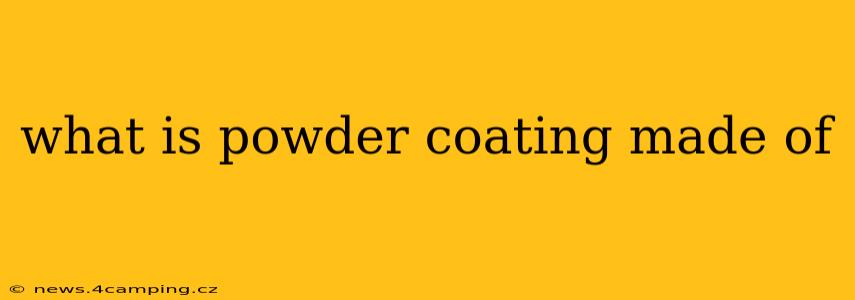Powder coating is a durable, aesthetically pleasing, and increasingly popular surface finish used across various industries. But what exactly is it made of? Understanding its composition is key to appreciating its versatility and performance. This detailed guide explores the ingredients, application process, and key benefits of powder coating.
What are the main components of powder coating?
Powder coating isn't a single substance but rather a blend of several key components, each contributing to its final properties. The core ingredients include:
-
Resin: This forms the binder, holding the other components together and providing the coating's film-forming properties. Common resins include polyester, epoxy, polyurethane, and acrylic. The choice of resin significantly impacts the coating's flexibility, durability, and chemical resistance. Polyester resins, for instance, are known for their excellent weatherability and UV resistance.
-
Pigments: These provide the color and enhance the coating's aesthetic appeal. A wide range of pigments are available, allowing for virtually any color imaginable, including metallic and pearlescent finishes. Pigments also contribute to the coating's overall UV protection and other properties.
-
Curing Agents: These are crucial for the chemical reaction that hardens the powder coating after application. They initiate the cross-linking process, transforming the liquid resin into a solid, durable film. The type of curing agent used depends on the resin system and desired properties.
-
Additives: Various additives are incorporated to enhance specific properties of the powder coating. These can include:
- Flow Agents: Improve the smoothness of the coating during application.
- Leveling Agents: Reduce surface imperfections and improve the overall finish.
- UV Stabilizers: Enhance resistance to UV degradation, preserving color and preventing fading.
- Antioxidants: Protect the coating from oxidation and degradation.
What are the different types of powder coating resins?
The choice of resin significantly influences the final properties of the powder coating. Here are some common types:
-
Polyester: Offers excellent weatherability, UV resistance, and chemical resistance. A popular choice for outdoor applications.
-
Epoxy: Known for its excellent adhesion, chemical resistance, and hardness. Often used in applications requiring high durability and corrosion protection.
-
Polyurethane: Provides excellent flexibility, impact resistance, and abrasion resistance. A good option for applications involving significant wear and tear.
-
Acrylic: Offers good color retention and is often used in applications where cost-effectiveness is a priority.
How is powder coating applied?
Powder coating involves an electrostatic spray process:
-
Pre-treatment: The substrate (the item being coated) is cleaned and pre-treated to ensure optimal adhesion. This often involves processes such as cleaning, degreasing, and phosphating.
-
Spraying: The powder coating material is electrostatically charged and sprayed onto the substrate. The charged particles adhere to the surface.
-
Curing: The coated item is then baked in an oven at a specific temperature and time, curing the powder and forming a durable, smooth finish. The curing temperature and duration depend on the type of powder coating used.
What are the benefits of using powder coating?
Powder coating offers several key advantages over other surface finishing methods:
-
Durability: It creates a very hard, durable, and chip-resistant finish.
-
Corrosion Resistance: Excellent protection against rust and corrosion, especially important for outdoor applications or in harsh environments.
-
Variety of Colors and Finishes: Allows for a wide range of colors, textures, and special effects.
-
Environmental Friendliness: Powder coating produces minimal volatile organic compounds (VOCs), making it an environmentally conscious option compared to liquid paints.
-
Cost-Effectiveness: Can be more cost-effective in the long run due to its enhanced durability and longevity.
What is the difference between powder coating and liquid paint?
While both provide surface protection and aesthetics, key differences exist:
-
Application: Powder coating is electrostatically sprayed and cured in an oven, while liquid paint is typically applied by brush, roller, or spray gun and air-dried or baked.
-
Durability: Powder coating generally offers superior durability and chip resistance.
-
VOCs: Powder coating is significantly lower in VOCs than most liquid paints.
-
Finish: Both can achieve various finishes, but powder coating often provides a smoother, more uniform finish.
This comprehensive overview provides a detailed understanding of powder coating composition, application, benefits, and comparison to other finishing methods. The versatility and durability of powder coating make it an increasingly popular choice across a wide array of applications.
